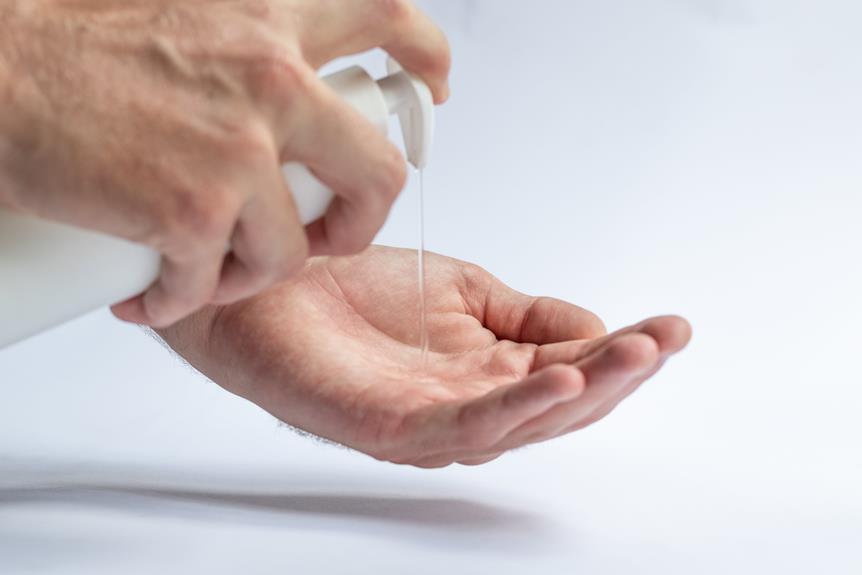Are you tired of wondering if your fabrics are safe with Loctite Super Glue Gel? Find out now and put your mind at ease. This comprehensive guide will provide you with the information you need to master the art of using super glue gel on fabrics.
You'll discover the types of fabrics that are compatible with Loctite Super Glue Gel, potential risks to watch out for, and expert tips for maximizing its effectiveness. Whether you're a seasoned crafter or a DIY enthusiast, this guide will equip you with the knowledge to confidently tackle fabric projects with super glue gel.
Let's dive in and become a pro at using super glue gel on fabrics!
Key Takeaways
- Loctite Super Glue Gel is compatible with cotton, denim, and polyester fabrics.
- It is important to clean and dry fabric surfaces before applying the glue for optimal adhesion.
- There is a potential risk of discoloration or damage to fabric fibers when using super glue gel.
- Testing a small, inconspicuous area of the fabric is advisable before applying the glue.
Types of Fabrics Compatible With Loctite Super Glue Gel
You can safely use Loctite Super Glue Gel with cotton, denim, and polyester fabrics. When it comes to fabric bonding, Loctite Super Glue Gel is a reliable adhesive for various materials. Whether you're working on a fabric repair or bonding different fabric pieces together, this adhesive provides a strong and durable hold.
It's essential to ensure that the fabric surfaces are clean and dry before applying the glue for optimal adhesion.
When using Loctite Super Glue Gel on cotton fabrics, apply a small amount of the adhesive to one of the surfaces you intend to bond. Press the surfaces together firmly and hold them in place for a few moments to allow the glue to set.
For denim, the process is similar, and the adhesive application offers a quick solution for repairing tears or securing embellishments. Polyester fabrics also bond effectively with this glue, providing a versatile option for a wide range of fabric projects.
While there are other bonding alternatives available, Loctite Super Glue Gel stands out for its ease of use and reliable performance, making it a go-to choice for fabric bonding and repair needs.
Potential Risks of Using Super Glue Gel on Fabrics
One potential risk of using Loctite Super Glue Gel on fabrics is the possibility of causing discoloration or damage to the fabric fibers. While super glue gel is a powerful adhesive that can create a strong bond, it can also have adverse effects on certain types of fabrics. When applied, the glue may seep into the fibers, causing discoloration or leaving behind a hardened residue that alters the fabric's appearance and texture.
Additionally, the chemical composition of the super glue gel may not be compatible with all fabric types, leading to potential damage such as weakening of the fabric or alteration of its original properties.
It's important to consider the specific fabric bonding needs and the potential risks involved when using super glue gel. Before application, it's advisable to test a small, inconspicuous area of the fabric to ensure that the glue won't cause any unwanted effects. This precaution can help prevent irreversible damage to your fabrics and ensure that the bonding process doesn't compromise the integrity of the material.
Tips for Applying Loctite Super Glue Gel on Fabrics
Enhance the adhesion process by ensuring proper surface preparation before applying Loctite Super Glue Gel on fabrics. Start by cleaning the fabric to remove any dirt, oil, or residue that could hinder the bonding process. Use a gentle detergent and water, then allow the fabric to dry completely before applying the super glue gel.
Additionally, consider roughening smooth fabric surfaces to create a better grip for the adhesive. You can lightly sand or use fine-grit sandpaper on the fabric, being careful not to damage or tear it.
When applying the Loctite Super Glue Gel, use it sparingly to avoid excessive seepage through the fabric. Apply a small amount to one surface and press the fabric together firmly. Be cautious to avoid getting the glue on your skin or other unintended areas. After application, allow the glue to dry completely according to the product instructions.
Keep in mind that drying time and bonding strength can be affected by environmental factors such as temperature and humidity. Consider these factors and take necessary precautions for proper application to achieve the best results when using Loctite Super Glue Gel on fabrics.
How to Remove Loctite Super Glue Gel From Fabrics
To remove Loctite Super Glue Gel from fabrics, start by gently scraping off any excess glue with a blunt edge, such as a spoon or the edge of a credit card. Be careful not to damage the fabric while doing so. Once you've removed as much of the excess glue as possible, check the fabric care label for any specific instructions.
If the fabric is machine washable, pre-treat the stained area with a stain remover or a small amount of heavy-duty liquid detergent. Allow it to sit for a few minutes, then wash the fabric in the hottest water suitable for the fabric.
If the fabric is dry clean only, take it to a professional cleaner and point out the glue stain. Avoid using heat or hot water on the stained area until the glue is completely removed.
Always test any stain removal method on a small, inconspicuous area of the fabric first to ensure it won't cause damage. With careful attention and the right approach, you can successfully remove Loctite Super Glue Gel from fabrics without causing permanent damage.
Alternative Fabric Adhesive Options to Consider
When working with fabrics, you can consider using fabric glue as an alternative adhesive option to Loctite Super Glue Gel. Fabric glue is specially designed for fabric repair and offers a strong adhesive strength to bond fabrics together securely.
Here are three alternative fabric adhesive options to consider:
- Liquid Stitch: This fabric adhesive provides a flexible and durable bond, making it ideal for repairing tears, hems, and seams in various types of fabric. It dries clear and remains machine washable, offering a reliable solution for fabric repairs.
- Aleene's Fabric Fusion: Known for its clear, non-yellowing formula, this fabric adhesive is suitable for a wide range of fabrics, including cotton, denim, and leather. It provides a permanent bond and is both machine washable and dry cleanable, making it a versatile choice for fabric projects.
- Beacon Fabri-Tac: This fabric glue offers a quick-drying, crystal-clear bond that's both washable and dry cleanable. It's suitable for bonding a variety of fabrics, making it a go-to option for fabric repairs and crafting needs.
These fabric adhesives provide reliable alternatives to Loctite Super Glue Gel, offering strong adhesive strength and versatility for various fabric repair and crafting applications.
Best Practices for Using Super Glue Gel on Fabrics
Considering the delicate nature of fabrics, using super glue gel requires carefully applying the adhesive to prevent any damage. Before applying super glue gel to fabrics, it's crucial to prepare the fabric by ensuring it's clean and free of any dirt or debris. Additionally, test a small, discreet area of the fabric with a tiny amount of super glue gel to ensure it doesn't cause any adverse reactions such as discoloration or damage.
When applying the super glue gel, use it sparingly to avoid saturating the fabric, which can lead to stiffness or hardening. It's important to work in a well-ventilated area and consider using gloves to protect your skin during the application process. Moreover, ensure that the fabric is laid flat and smooth during the application to prevent any wrinkles or uneven distribution of the adhesive.
Always follow the safety precautions outlined on the super glue gel packaging, and if possible, consider working in a well-ventilated area to minimize exposure to fumes. By following these best practices, you can effectively use super glue gel on fabrics while minimizing the risk of damage or unwanted outcomes.
Common Fabric Projects Suitable for Super Glue Gel
You can use Loctite Super Glue Gel for common fabric projects that require a strong and precise adhesive. When working on fabric bonding or clothing repair, this powerful adhesive can be a game-changer for your DIY projects. Here are three common fabric projects suitable for Loctite Super Glue Gel:
- Hemming pants: Whether you're shortening a pair of dress pants or fixing a tear at the hem, using Super Glue Gel can provide a quick and durable solution. It creates a strong bond that holds up well against daily wear and tear.
- Attaching patches: When you want to add patches to your denim jacket or backpack, Super Glue Gel offers a reliable way to securely attach them. This method ensures that the patches stay in place even after multiple washes.
- Fixing fabric embellishments: From beads to sequins, Super Glue Gel can effectively secure various embellishments onto fabric. It provides a precise application, preventing any excess glue from ruining the intricate details of your project.
These are just a few examples of how Loctite Super Glue Gel can be a valuable tool for your fabric projects, offering a strong and lasting bond without the need for sewing.
Expert Tips for Maximizing Super Glue Gel Effectiveness on Fabrics
To maximize the effectiveness of Loctite Super Glue Gel on fabrics, consider the fabric compatibility and the best removal and cleanup methods.
Understanding these expert tips will help you achieve the best results when working with fabrics and super glue gel.
Let's explore these points to ensure a successful and lasting bond.
Fabric Compatibility Considerations
Maximizing the effectiveness of Loctite Super Glue Gel on fabrics requires careful consideration of compatibility factors. To ensure the best results, keep in mind the following expert tips:
- Fabric bonding techniques: Before applying the Super Glue Gel, it's crucial to understand the fabric's composition and weave. Certain fabrics may require different bonding techniques to achieve optimal adhesion.
- Adhesive application techniques: The way you apply the Super Glue Gel can significantly impact its effectiveness on fabrics. Proper application methods, such as applying a thin, even layer and using minimal pressure, can enhance the bond without damaging the fabric.
- Compatibility testing: Prior to full application, always conduct a compatibility test on a small, inconspicuous area of the fabric to ensure that the Super Glue Gel adheres well without causing any damage.
Removal and Cleanup Methods
For effectively removing and cleaning up Loctite Super Glue Gel from fabrics, it's important to follow a strategic approach. Firstly, gently blot the affected area with a clean cloth to remove any excess glue. Then, use the table below for specific removal techniques based on the type of fabric. After the glue is removed, it's crucial to prevent staining by washing the fabric immediately or using a stain remover. Always remember to test any cleaning solution on a small, inconspicuous area of the fabric first to ensure it won't cause damage. By following these expert tips, you can maximize the effectiveness of Loctite Super Glue Gel on fabrics while minimizing any potential cleanup issues.
| Fabric Type | Removal Technique |
|---|---|
| Cotton | Warm Soapy Water |
| Wool | Vinegar Solution |
| Silk | Acetone |
| Polyester | Rubbing Alcohol |
| Denim | Freezing and Scraping |
Frequently Asked Questions
Can Loctite Super Glue Gel Be Used on Delicate Fabrics Like Silk or Chiffon?
You shouldn't use Loctite Super Glue Gel on delicate fabrics like silk or chiffon. It can damage the fabric. For fabric repair, consider using fabric glue or sewing for a safer option.
Will Loctite Super Glue Gel Leave a Visible Residue or Stain on Fabrics?
Loctite Super Glue Gel may leave a visible residue or stain on fabrics. To remove it without damaging the fabric, use acetone or nail polish remover. Apply a small amount and gently dab the affected area.
Is It Safe to Use Loctite Super Glue Gel on Fabrics That Will Be Washed or Exposed to Water?
Loctite Super Glue Gel is safe for fabrics and offers durability. It withstands washing and exposure to water, maintaining waterproofing and bonding strength. You can trust it for fabric projects that need a reliable adhesive.
Can Loctite Super Glue Gel Be Used on Fabrics With Embellishments or Decorations?
You can use Loctite Super Glue Gel on fabrics with embellishments, but be cautious with delicate fabrics. Apply a small amount and test in an inconspicuous area first. This helps avoid any potential damage to the fabric or decorations.
Are There Any Specific Fabrics That Should Be Avoided When Using Loctite Super Glue Gel?
When using Loctite super glue gel, avoid delicate fabrics like silk and chiffon. It may leave a visible residue and could affect fabric washing and water exposure. Exercise caution with embellished fabrics to ensure decoration safety.
- Does Chiffon Fabric Stink - July 15, 2025
- Does Chiffon Fabric Affect the Economy - July 15, 2025
- Does Cotton Fabric Have a Nap - July 15, 2025







